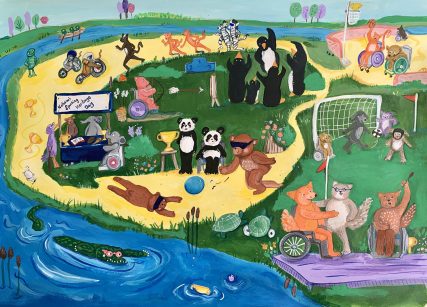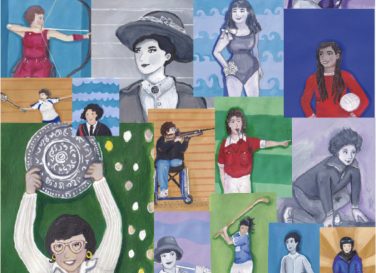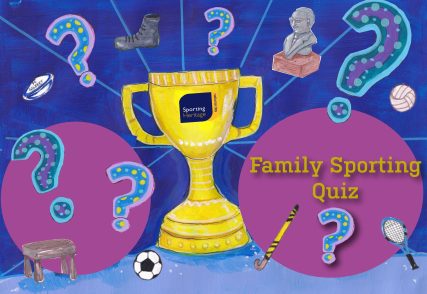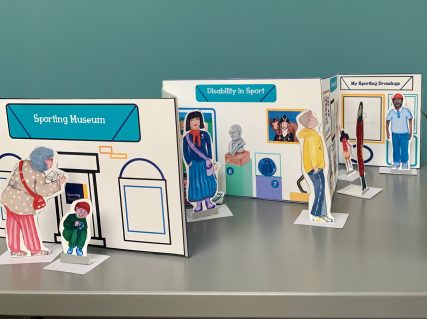Case study: Working with an illustrator
From Our Toolkit
Hidden Histories Illustrated project – Jessica Hartshorn, illustrator
Illustrations can be pivotal in bringing collections and stories to life and introducing ideas to new, young audiences and enriching education and learning programmes.
Background to the project
In October 2020, the funding for The Hidden Histories Illustrated project was granted by Arts Council and Illustrator, Jessica Hartshorn, set to work in partnership with Sporting Heritage CIC and 50 sporting museums. The project aimed to innovatively show heritage through 8 illustrated online family resources for each school holiday. We aimed to not only provide invaluable free activities, but also to connect museums, sharing their untold stories of women in sport, disability in sport and unusual objects. Over a 12-month period, Jessica created content and illustrations for each resource in collaboration with the museums. Lead contacts from each museum provided photographs, archives, and information for each resource. Museums were divided between each resource, with some taking part in most resources and other may be only part of one, whilst others only distributed and marketed the end result. This was the first time Sporting Heritage and many of the museums had worked with an artist in this way and the project was a significant learning curve of how to utilise artists and create bespoke activities. The project was a important example of how artwork and illustrations can enhance education programmes and collaborate with a creative practitioner, to think outside the box when it comes to collections.
How was the need for this project identified?
During the current pandemic, it has been integral that museums work closely together to support each other in new ways of working whilst continuing their important and positive heritage education work. Many museums’ teams have struggled to transition from physical education offers to digital opportunities due to lack of capacity and funding, yet the demand of blended learning is growing. It was identified that many museums wanted to collectively connect to share education resources and in response to covid 19 support freelance and deliver digital activity. The project was an opportunity to deliver a creative joint network project across the SSN (UK WIDE) using illustrations as a fun and accessible method of showcasing hidden histories. At the same time, Jessica created templates and systems for future use within the network and develop confidence of staff in working with artists.
Some of the aims of the project included:
- To create a series of 8 online resources in partnership with sporting museums across the UK over 12 months
- To work with 3 core themes: women in sport, disability in sport and unusual objects
- To increase online family audiences (7-14 years)
- To build awareness and challenge stereotypes of the various sporting collections, particularly less highlighted stories of women and disability in sports
How was the project delivered?
Over the 12-month period 8 resources were created with nearly 50 organisations across from the UK. These included colouring in sheets, quizzes, templates and card games to digital activities the UK. The process of working with Jessica was established at the beginning of the project and aimed to keep the work for the sporting organisations to the minimum.
The brief for the activity was outlined, for example ‘to create a digital matching game of sporting accessories, each object would be illustrated in colour and with a plain background.’ The museums would supply an image for reference and a paragraph of information to accompany each object. The dates would be agreed for the delivery, deadlines and launch of the activity and the team members and museums were informed.
Jessica would illustrate by hand in acrylic paint the artwork and scan ready for the activity and add the text and links etc. We would then proof, run past an access consultant approval and sign off the activity. Finally, we shared the resource on the SH website, a link sent to all organisations involved with marketing guidance.
What impact did the project have?
The project allowed Sporting Heritage and other organisations to increase its audience reach, accessibility and raise awareness. The various activities created a buzz around National Sporting Heritage Day and particularly the Female Sporting Heroes card game, which was picked up by radio stations and widely shared on social media, with sports stars sharing and commenting. It was clear the artwork helped to raise the profile of hidden and ignored heritage which highlighted and brought awareness to collections. There is also now a healthy bank of bespoke illustrated resources which can be used in the future. Staff from the various museums have also commented on how they have enjoyed the process and learnt a huge amount about working with illustrators and it has been an enlightening and positive experience.
Finally, working with an artist is now embedded within Sporting Heritage’s ongoing and future activity. There is potential to develop the work further as part of the learning offer and possibly generate income by offering the resources as part of a larger education package with a charge.
Contributing to the Hidden Histories project has been a great experience for the R&A World Golf Museum. We have been able to showcase our Nationally Recognised Collection to new audiences, through innovative and creative projects. We have not collaborated with an artist in this way before, and it has proved to be an excellent vehicle for sharing stories of sporting heroes to younger audiences. Bringing together different organisations from across the network has also been so effective. Working with Jess has been a wonderful process, and I have taken so much enjoyment at seeing how she has interpreted various aspects of golf heritage in her illustrations. We would be delighted to feature in any future plans.
Hannah Fleming, Learning & Access Curator, R&A World Golf Museum
What are the benefits of working with a creative practitioner?
There are so many benefits to working with an illustrator for your education programme. These include:
- To use illustration as part of the learning program to bring the text to life, create resources which are unique and special for the organisations.
- To create visually interesting resources.
- Eye catching methods to reference and link back to each museum.
- Beautiful and bespoke illustrations.
- Outsourcing to freelancers helps to provide resources when there is limited capacity within the museum.
- Small museums/ archives might have their first step into education working in collaboration with an artist.
- Providing the artists with inspiration and exciting collections to work with and support the development, profile and portfolio of their work.
Top tips for working with an illustrator
There are many different ways you can work with an artist to support your learning programme and there and many different artists and makers out there too! From art workshops in your venue, commissions of artwork or murals, sculptures, selling related craft or art items in your shop. You may wish to work with an illustrator to create a map of your site, create colouring sheets, trails, bring to life education packs and much more.
Where possible have a clear brief of what you would like. Find examples of what other museums who have produced to show the artist. This helps to understand the feel of the type of thing you are after.
Your brief should include:
- An overview of what you would like the artist to do. I.e. illustrate the front cover of a museum brochure. Agree the process and the roles of everyone involved.
Talk about what the aim of the artwork is. - You may wish to provide images for reference. If so, you may need copyright of these images.
- The size you would like and the format.
- Your timescales and deadlines
- Costings
- The illustrator may have their own contract linked to copy right and distribution.
- Arrange a meeting (potentially virtual) to talk through your ideas.
- If you are not sure what you want, that’s ok. Talk to the artist and work together to develop something that suits your organisation’s needs.
- Draw up a contract to detail all of the above.
- Pay the freelance on time. Depending on the length of the project and what is involved, some artists would expect a payment schedule in which the payment is issued at certain landmarks, with the final instalment at the end of the project.
But more than anything, enjoy the process and don’t be afraid to ask the artist if you are not sure about something.




